The Dixon Water Foundation Josey Pavilion
Project Overview
The Josey Pavilion is a multi-functional education and meeting center that supports the mission of the Dixon Water Foundation to promote healthy watersheds through sustainable land management. Traditionally livestock has caused more harm than good by overgrazing and not allowing our native prairies to play their important role in habitat and watershed protection, and carbon sequestration. The Josey Pavilion facilitates a deeper understanding of how grazing livestock as well as the built environment can work to do more good than harm.
As stated by Dr. Lisa Bellows, a North Central Texas College biology professor that uses the facility regularly, “The pavilion is a place for learning and gathering, for laughing schoolchildren with muddy hands and ranchers swapping stories and strategies. But it is also a space for tranquility. There is no omnipresent mechanical whirring that pervades the soundtrack to most Texans’ indoor lives. Seated in the herbarium or resting on the porch, you can listen deeply, to the prairie silence, or the shush of grasses and quiet clatter of oak leaves in a breeze. You feel tapped into a purposeful stillness, like being in the middle of a grazing herd, one being working dutifully among many, interconnected in a balanced whole.”
Design & Innovation
The client’s initial goals were clear: design a comfortable meeting and education facility to shelter those that come to learn how the Dixon Water Foundation uses livestock as a tool to restore our native prairies and create healthier watersheds. The facility was to have no active heating or cooling and be designed to adapt according to the weather conditions on any particular day. This led to a building that could fold and unfold based on temperature and wind conditions. A building that embraced the simplicity and serenity of the North Texas prairie while serving as a lens through which the land is better understood and appreciated.
This vision broadened once we approached the client with the idea of creating the project to be a fully restorative, Living Building that would seek the same ecological equilibrium achieved at Dixon Water Foundation ranches while creating an immersive experience of biophilic place. The building now goes well beyond the criteria of providing shelter for learning and tells a stronger story that expands the audience of the Dixon Water Foundation and fully supports a deeper understanding of rangeland conservation and its important collateral benefits, including carbon sequestration and water, energy, and ecosystems balance.
Regional/Community Design
Our world’s native prairies have been disappearing due to poor land management and a lack of understanding about the holistic value of our native prairies. The Dixon Water Foundation works regionally and internationally to reverse this trend. The 2014 Holistic Management International Conference was held at the pavilion’s education center. People from Canada to Africa attended the conference which focused on motivating, connecting, and supporting farmers, ranchers, and land stewards through the practice of Holistic Management that improves environmental health, sustains economic viability, and enhances the quality of life of farm and ranch communities.
Local ranchers hold monthly meetings at the education center and find comfort and familiarity in the simple execution of the pavilion’s vernacular form with large overhangs and deep and inviting porches. Civic and school students frequently travel by bus to visit the education center for field days learning about watershed health, wildlife, and native plants. Kids on the Land, a program sponsored by the foundation, uses an integrated Science, Technology, Engineering, and Mathematics approach to teach children about the region where they live. The program uses the Josey Pavilion to help connect children to the land and encourage them to live a more sustainable future.
Metrics
Land Use & Site Ecology
The Josey Pavilion fosters human connection to land and water. Careful siting strategies employed biophilic design to provide a sheltered perch as an enticing place of safety and comfort from which visitors can survey the horizon. The building consists of two identical, low slung, gabled roofs that form a shady courtyard around a Heritage Live Oak and then are slightly pulled apart to allow for a large, shared gutter that celebrates the value of collected rainwater. Upon entry, visitors see the termination of the shared gutter where rain chains descend into a concrete trough fed by recirculating collected rainwater. This shallow trough provides habitat for birds and mammals while serving as an element of enjoyment for visitors that sit along the porch, hear the trickling of the water, and appreciate the role the water plays in cooling the summer breezes that pass over the trough. Overflow from this trough is captured by a series of swales that slows down the stormwater, allowing it to gradually seep into the ground nourishing the Live Oak and replenishing the Trinity Aquifer below.
Bioclimatic Design
The Josey Pavilion was designed to have no active heating or cooling and adapt according to the weather conditions on any particular day. Gapped wooden doors open to allow maximum ventilation through the central gathering space and along porches that are oriented to capture the cooling summer breezes from the southeast. Glass pivot doors on the east and west of the education center can be adjusted to allow the southeast corner to be entirely open, maximizing the impact of these cooling breezes.
The cupolas not only provide daylight for the spaces, but also utilize the negative pressure resulting from breezes gliding over the roof, helping to draw hot air out of the pavilion and increasing the velocity of the air moving through the space.
The education center’s building elements can also be adjusted to provide shelter from harsh northwestern winter winds. With an openness factor derived from that of a tree, the gapped wood pivot and sliding doors help block wind that would otherwise whip through the porches and spaces between the buildings. The cupola windows can be closed in winter to help keep more warm air in and minimize air flow through the space.
Light & Air
The Josey Pavilion was designed to act like a singular tree on the prairie. Just like the Heritage Live Oak that defines the site, the building tempers the climate and enhances visitor experience by shading the sun, blocking the wind, and providing protected views. Though protected, visitors are still connected to the outside, experiencing filtered daylight and natural ventilation in every space of the project.
The main meeting space is oriented along an east-west axis, ideal for both daylight and natural ventilation, with slatted doors on the north and south and a central rooftop cupola to allow light and air into the space. Each of the other, more enclosed spaces, employ similar strategies to provide daylight, views, and fresh air.
Though simple, nothing about the design of these strategies was taken for granted. Simulations were used to ensure that daylight would be adequate and even a CFD analysis was used to study air flow through and around the space. After completion, daylight measurements confirmed that the spaces were bright and visually comfortable while air quality testing confirmed that the air inside each of the spaces was just as fresh and clean as the air over the prairie.
Metrics
Water Cycle
The Josey Pavilion acts as a demonstration tool for how to mitigate the negative effects of waste and storm water. Rainwater is collected from the roof and stored in a 13,000-gallon cistern. This water is used for sewage conveyance and occasional irrigation needs. The constructed wetland cleanses and returns all of the water used in the pavilion back to the aquifer. Thus the groundwater pumped into the pavilion’s sinks eventually becomes groundwater again. In this way, as guests interact with the project’s water systems, they are connected with a small-scale water cycle that parallels how rain is collected in a watershed, used by plants and people, processed by wetlands—nature’s kidneys — and returned to aquifers belowground.
A remote project would typically use a septic system and leach field to treat wastewater; however, septic systems are a leading causes of groundwater pollution because they do not effectively cleanse excess nutrients. The Josey Pavilion demonstrates a better way of treating wastewater and protecting our watersheds. The constructed wetland alone has attracted many visitors including the Waste Water Manager for the nearby city of Denton and groups of college students from the University of North Texas.
Metrics
Energy Flows & Energy Future
The main energy reduction strategy of replacing mechanical systems with passive systems resulted in a savings of the 334,194 kBtu of energy which prevents 72 tons of carbon emissions. It takes 180 hectares of grassland one year to sequester that same amount of carbon.
Due to this lack of active systems, the remaining energy use was for hot water, ceiling fans, lighting, plugs, equipment, and appliances. Hot water was limited to the kitchen and is supplied by a point-of-use instant water heater, which reduced water heating energy by more than 90% once occupancy patterns were established. Lighting is LED and controlled by timers and sensors so they are off when the building is not occupied. Kitchen appliances were also chosen for efficiency.
The biggest unknown was the constructed wetland system, which ultimately uses more than half of the project’s energy. This system of pumps and filters has varying run times based on use and rainfall. Because of this, we monitored the building's energy on a daily basis and made adjustments to save energy whenever possible.
The final component of our energy strategy is the 4kW solar array, which offsets more that 150% of the project’s energy use.
Metrics
Materials & Construction
Transparency was the focus of every step of our material process. From advocating for manufacturers to disclose the chemical components of their products to publishing the final material matrix on our website, we went beyond the rigorous requirements of the Living Building Challenge to ensure the rest of the architecture community could also benefit from our efforts.
All 186 materials that comprise the Josey Pavilion were thoroughly vetted to ensure that materials were red list free, locally sourced and manufactured, and harvested sustainability. Our strategy employed a simple material palette focusing on products that were minimally processed and naturally durable. The Sinker Pine wood structure and siding required no chemical treatments. The steel was allowed to rust, naturally forming a protective layer without the need for chemicals or maintenance. The low, unfinished concrete perimeter walls were designed for sitting but also act as a durability element by raising the base of the wood columns and walls up and reducing the wood’s exposure to rain and sun. The materials used were no different than those used at most Texas ranches, which evokes a comfortable familiarity and authenticity not commonly found in the modern built environment.
Long Life, Loose Fit
The Josey Pavilion is designed to last the test of time. A simple palette of naturally durable materials is used and the most delicate of these materials, the Sinker Long Leaf Pine, is protected by large overhangs and lifted off the ground by a concrete wall that also serves as a seat wall along the edge of the porches.
Though the clients did not come to us asking for a building that could grow as the foundation’s needs change, the Josey Pavilion is constructed in a way where long-term flexibility and adaptability is possible. Bolted connections were used throughout the structural frame, which would allow for easy deconstruction and reconstruction. Also, the buildings consists of two identical gable forms. At three of the four gable ends, porches form the last structural bay and protect the end walls from the harsh east and west sun. In the main meeting space, these porches could be captured and the large glass pivot doors that currently enclose the space could be removed and re-set at the outer-most structural bay to gain an additional 900-square-foot meeting space.
Collective Wisdom & Feedback Loops
The integrated design team worked closely throughout the entire process to ensure the building and systems would function as was intended. Our engineers performed CFD modeling to study air flow through and around that space that helped us determine the necessary open area in our slat doors to significantly reduce the velocity of the wind when necessary without creating pockets of negative pressure. Simulations were also used to ensure that daylight would be adequate to provide balanced light in each of the spaces and eliminate the need for electrical lighting during the day.
After completion and over a year of occupancy, daylight measurements confirmed that the spaces were bright and visually comfortable, wind metering and occupant surveys confirmed our wind blocking/inviting strategies were successful, and air quality testing confirmed that the air inside the space is just as fresh and clean as the air outside. Our energy monitoring allowed us to adjust equipment such as the thermostat for the emergency heater in the water system equipment room so that the building could perform more efficiently than was predicted.
Primary lessons learned include how to better winterize a non-heated building and successful implementation of bird friendly design strategies.
Other Information
Now that we have a built Living Building (pending certification), we are many times asked, “What is the cost of a Living Building?” The Dixon Water Foundation did not ask that question, but rather asked, “What is the value of a Living Building?” To the Dixon Water Foundation, the value in potentially having the first Living Building in Texas, a building that sought to achieve the same ecological equilibrium they seek to achieve at their ranches, was in elevating their mission to an international level beyond the groups of land management organizations that are currently aware of their work.
Once it was determined that we would seek to achieve a Living Building, the design concept did not change because the basic project goals remained the same – only a photovoltaic array and a constructed wetland were added. The hard cost for these added systems plus meeting some of the materials requirements (primarily wood sourcing) did not exceed $150,000, which equates to about 8% of the final construction costs. The clients knew that a septic system would cost less, but it was contrary to their mission of watershed protection.
We first met with Betty and Clint Josey, the Dixon Water Foundation staff, and key stakeholders to discuss their vision and goals for the project. During this visioning meeting, the client group did not ask for a Living Building. They had never heard of the Living Building Challenge; however, the mission of the foundation is to demonstrate how livestock can be a part of a healthy ecosystem and, after we presented the concept design for the project, the client saw a Living Building as an opportunity to strengthen their message by providing an educational venue that seeks to achieve the same ecological equilibrium as their range management program. They saw the building as an opportunity to tell a stronger story that expands the audience of the Dixon Water Foundation and fully supports a deeper understanding of rangeland conservation.
In order to reduce the additional cost burden, we offered to work free of charge on the Living Building Challenge research and documentation through our commitment to the 1+ Program. Most of the 1,537 hours we have worked on the Living Building Challenge documentation so far was during the submittal process when each material had to be thoroughly vetted. The matrix we produced from this process has been made public, which supports our belief that our time and research should benefit the entire industry.
Over the yearlong occupancy period, daylight measurements confirmed that the spaces were bright and visually comfortable (an even 40 fc), wind measurements and occupant surveys confirmed our wind blocking/inviting strategies were successful and air quality testing confirmed that the air inside the space is just as fresh and clean as the air outside. Our energy monitoring allowed us to adjust equipment such as the thermostat for the emergency heater in the water system equipment room so that the building could perform more efficiently than was predicted.
Additional Images
Project Team and Contact Information
| Role on Team | First Name | Last Name | Company | Location |
|---|---|---|---|---|
| MEP Engineering | Ben | Cole | TLC Engineering for Architecture | Dallas, TX |
| Structural Engineering | Stephen | Price | Datum Engineers | Dallas, TX |
| Civil Engineering & Wastewater | Jon | Hathaway | Biohabitats | Raleigh, NC |



















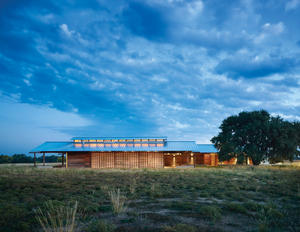
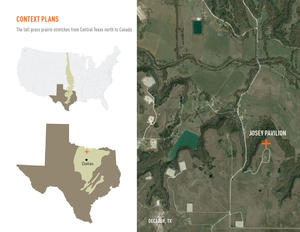
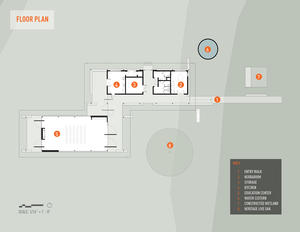
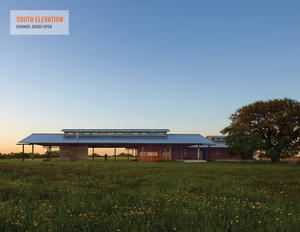
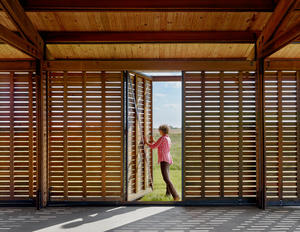
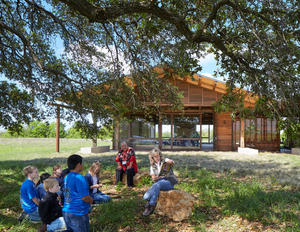
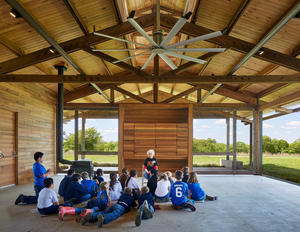
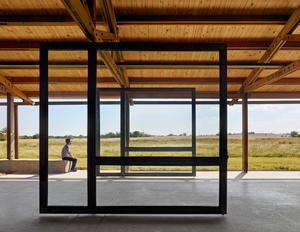
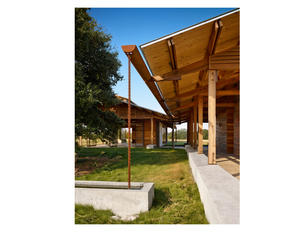
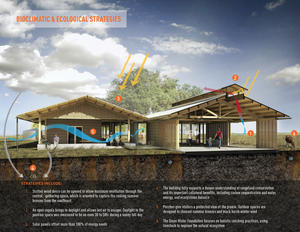
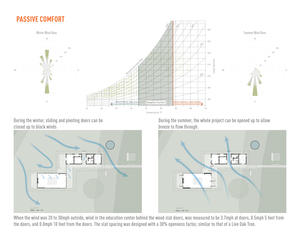
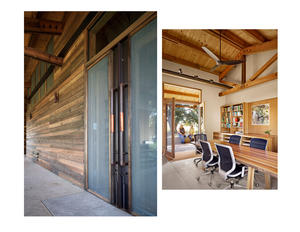
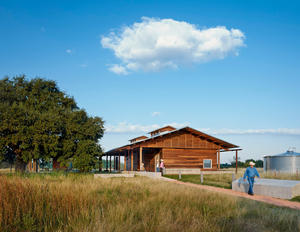
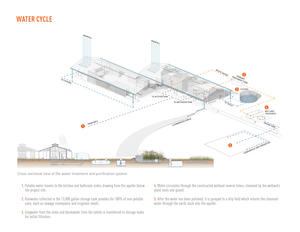
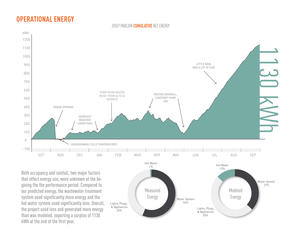
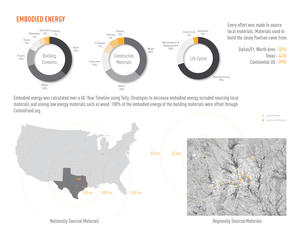
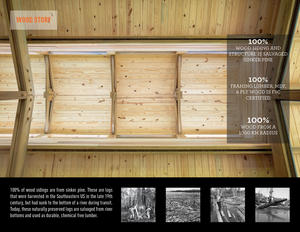
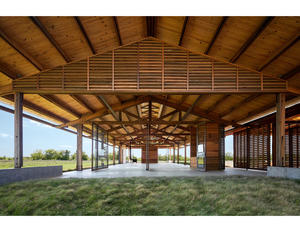
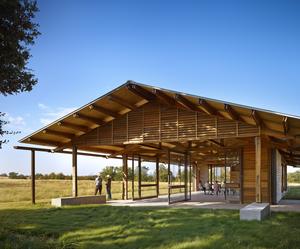


This is the perfect example of design excellence and sustainability working hand-in-hand. Elegant bioclimatic response to program and site. The vernacular forms fit the site and are appropriate to the Foundation’s mission of sustainable agriculture. We loved that the design allowed much of the program to function without conditioned interior space. Who needs walls? The architects thought outside of the box. The jury particularly appreciated the clarity of thought, the elegance of the parti, reinforced by a simple palette of locally sourced, low-carbon materials. Beautifully detailed.